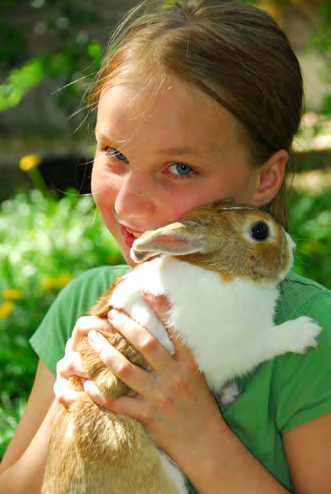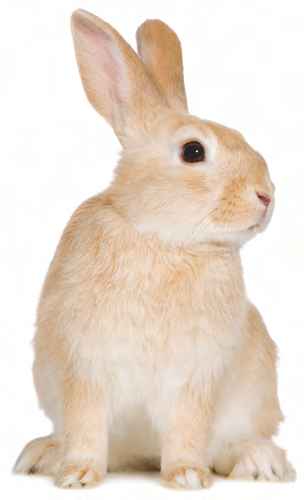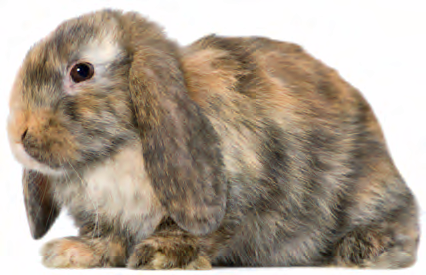Raising Rabbits in Alaska
LPM-00745 View this publication in PDF form to print or download.
by Derylee Hecimovich
Rabbits can be both excellent pets and versatile livestock animals in Alaska. They offer an array of sizes, colors and coat choices to fit most any project or situation. They can be raised in much smaller spaces and at less cost than most other livestock, and they reproduce more often for a steady supply of protein. Rabbits can be house trained to live inside, out of a cage, and to use a litter box, making them ideal pets for all ages. A rabbit may live as long as a dog or a cat, so keep this in mind — along with all aspects of animal keeping — when considering a rabbit for a pet.
Wild rabbits and hares have long been used by humans for food and were first domesticated by monks in the Middle Ages. Wild species in Alaska include the Arctic hare, Lepus othus, and the snowshoe or varying hare, Lepus americanus.
All others are introduced domestic breeds, Oryctolagus cunniculus. The meat is very palatable, high in protein and low in fat, sodium and cholesterol. The fur pelt is used in a wide variety of products, and soft, fine Angora rabbit wool is prized by spinners and fiber artists. Rabbits are also used in laboratory research and as therapy animals. Showing rabbits is both a popular hobby and a business opportunity. Keeping rabbits in Alaska is relatively simple; all you need is adequate housing, nutrition and care to keep them healthy and happy.
BREEDS AND TYPES
The American Rabbit Breeders Association (ARBA) currently recognizes almost 50 breeds of rabbits. Breeds vary in size, shape, color, fur type and temperament. Crossbreeds add even more choices, so it is important to decide why you want to raise rabbits. All rabbits can be used for meat or fur and most make good pets, but certain breeds are preferable for specific purposes. It costs the same to feed a purebred or a crossbred rabbit, but other costs may vary with breed.
For example, purebred rabbits may cost more initially, but they are eligible for show and their offspring may be sold for higher prices.
It is a good idea to research the breeds, talk to rabbit breeders and owners, and attend rabbit shows to see and learn more about different breeds before making a final decision. Some breeds may not be available in Alaska and may need to be shipped in, leading to additional expenses. If you are only looking for a pet, animal shelters and rescue organizations may have animals in need of a home.

 Rabbit fur is recognized in four types. Most common is “normal” fur. A Satin coat
has a high sheen, Rex fur is very short and velvety, and wool or Angora fur is very
thick and long. Angora-type rabbits may require extra grooming to keep the coat manageable.
Rabbit fur is recognized in four types. Most common is “normal” fur. A Satin coat
has a high sheen, Rex fur is very short and velvety, and wool or Angora fur is very
thick and long. Angora-type rabbits may require extra grooming to keep the coat manageable.
BASIC HEALTH
Healthy rabbits should appear alert and active with bright eyes and a shiny coat, not show any signs of injury or illness and be of proper weight. A daily examination will help identify any health problems early and make the animal easier to handle. This is a good time to routinely clip the rabbit’s toenails. Calm, careful handling should be practiced to reduce injury to the rabbit and owner. A rabbit should be picked up by the loose skin over its shoulders with its back end supported and carried in the crook of your arm. Young rabbits should be six to eight weeks of age before leaving their mother for a new home and should be eating and drinking well on their own. It is a good idea to quarantine any new rabbits, or ones that have been exposed to others, separate from the rest of the rabbitry for at least two weeks. You will want to research common rabbit diseases and health issues so that you are familiar with potential problems, such as coccidiosis, which can be an issue in some areas. Check with your veterinarian for specific health care recommendations.
Prevention is the best key for maintaining healthy animals. Proper control of temperature, humidity, drafts, ventilation and lighting, along with clean water, quality food and overall cleanliness, will reduce potential health-related problems. Wash and disinfect your hands and clothing often as an additional way to prevent health problems.
HOUSING
Rabbits are territorial and are best housed separately to avoid fighting, especially between bucks, and unwanted litters. A suggested hutch size is three-fourths of a square foot per pound of mature weight. Cages should be easy to clean, at least partially roofed and out of direct sunlight, drafts, rain and snow. Rabbits can tolerate the cold, so the area should be well ventilated to prevent ammonia buildup. Fans may be needed in warm weather. The hutch should also be predator and rodent proof, and manure should be removed often to reduce insects. Metal wire hutches are easier to keep clean and are preferable to wooden cages. A monthly cleaning with a bleach solution of 1 ounce bleach to each quart of water will reduce disease. Hutches may be raised off the ground or stacked with trays underneath to catch waste. Be sure to predator proof under the hutch, since many rabbits are lost to dogs and other predators attacking from beneath. A board placed on the bottom of the hutch may be used to keep the rabbit off the wire cage floor during cold snaps.
During the winter months, when natural light is limited, rabbits may benefit from some supplemental full-spectrum lighting. Keep any electrical cords out of reach.
NUTRITION
Rabbits should have access to fresh liquid water all times. Commercial water bottles, automatic water systems or heavy dishes may be used. Be sure to regularly wash and occasionally bleach and thoroughly rinse the watering equipment. Feeding may be free choice (continuous) or at scheduled feeding times. Feeders may be commercial metal hanging feeders or heavy dishes; be sure to clean these on a regular basis. Depending on age and size, smaller breed rabbits consume 2 to 6 ounces and larger breeds 6 to 10 ounces of pelleted feed per day.
A good commercial, pelleted rabbit feed should supply all of a rabbit’s nutritional needs. They will also need a calcium-phosphorus and trace-mineralized salt. Occasional treats of carrots, other vegetables or alfalfa hay are alright, but should not be the regular diet. Cabbage can cause upset stomachs. If a feed change is necessary, it should be done gradually to avoid digestive problems. Occasionally, you may observe your rabbit doing what seems to be eating their own feces. This is normal and called coprophagy. In reality, the rabbit is actually eating cecotope pellets produced in the animal’s cecum, aiding its digestive process.

Feed is best stored in a cool, dry place in rodent proof containers. Check the manufactured date, usually printed on the feed bag tag, to ensure fresh feed. Feed stored beyond four weeks loses quality and can become rancid.
REPRODUCTION
Depending on your goals, you may decide to breed your rabbit. Rabbits not intended for breeding may be spayed or neutered. You should start by determining the sex of your rabbit, if you have not already done so. This may be done by gently holding the rabbit on its back and applying light pressure slightly above the genital opening with your thumb and index finger. A male (buck) will have a round protrusion, a female (doe) will have a slit. Rabbits are easier to sex after weaning. Rabbits should not be bred until they are sexually mature, usually four to six months for small breeds, seven to nine months for medium breeds and nine to 11 months for large breed rabbits.
Always take the doe to the buck’s cage when breeding. Female rabbits do not have regular heat cycles (estrus); if the doe is not receptive, remove her and try again another day. After a successful breeding, the gestation period averages 31 days. A doe may be palpated as early as the tenth day after breeding to determine whether she is pregnant.
A few days before the due date, add a nesting box to the hutch, where the doe gives birth (kindles) and cares for the babies (kits). The box should be 2 to 3 inches longer and wider than the doe when sitting and 6 to 12 inches high, depending on breed. The box may be made of wood, plastic or metal and should be sanitized between uses. Straw, shredded paper or pine shavings (not cedar) may be used as bedding. You may also need to line the cage with narrow gauge mesh to keep the babies from falling out of the hutch.
During and after birth it is best to leave the doe undisturbed, but be sure to provide ample fresh water at this time. Do not handle the kits unless absolutely necessary, but check the nest box after a day to remove any dead kits and replace soiled bedding. The babies are born without fur and with eyes closed. Their eyes will open around day 10. Rabbits may be weaned at six to eight weeks of age, when they are able to eat and drink sufficiently on their own. If they go to new homes, it is a good idea to send some of the feed they have been eating with them to ease the transition. They may be housed in separate cages or as a group until breeding age.
Depending on the age and condition of the doe and number of litters per year desired, she may be rebred after kindling. Does that produce more litters per year will have a shortened breeding life and may need replacing sooner that those with fewer litters. Depending on your rabbit raising goals, you may want to research genetics and other detailed topics of rabbit reproduction specific to your interests.
OTHER CONSIDERATIONS
Keeping records of your rabbit can be an important aspect of rabbit husbandry, even if your rabbit is kept just as a pet. For business purposes you will need detailed information on all aspects of your operation, including pedigrees, health records, growth rates of kits, marketing and sales. Ear tattooing is the identification method used by ARBA and other purebred rabbit registries and may be done as the rabbits are weaned. Be sure to check on the required tattooing system and method for your breed of rabbit. Local rabbit clubs may offer tattoo clinics.

If you are raising meat rabbits, be aware that most rabbits are processed as fryers at 10 weeks of age or less and 3 to 5 pounds. Rabbits may be sold at live or dressed weight. Processing should be done in a sanitary environment, using gloves and sanitized equipment. Approved processing methods should also be followed. Rabbit meat may be used in many ways. The pelt may also be harvested and processed at this time.
If you have purebred, registered animals, you may want to participate in rabbit shows. This can be a fun and informative way to learn about and enjoy your rabbits. Check with ARBA or local rabbit clubs for more information about shows in your area and how to prepare your rabbit for showing. Show rabbits may require a more specific feeding, handling and grooming regime.
SUMMARY
Whether as pets, fur or wool providers, or show or meat animals, rabbits can become a viable hobby or business in most areas of Alaska. They are fairly simple to care for, fit into most any housing situation and are an affordable protein alternative to other domestic livestock. For further information on rabbits, consult the following sources:
American Rabbit Breeders Association: www.arba.net/index.htm (the specific breed associations also have many resources).
Rabbit Resource Handbook. 2004. The Ohio State University.
Derylee Hecimovich, Extension Faculty, 4-H and Youth Development
Reviewed November 2014
